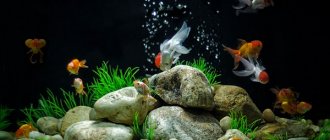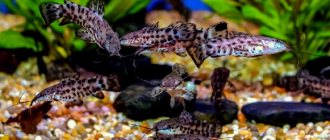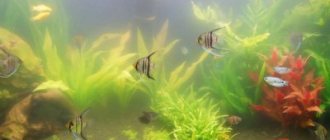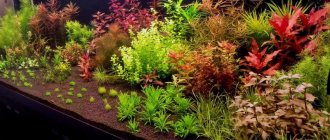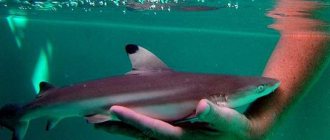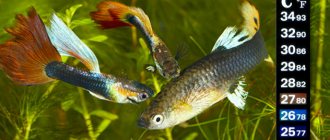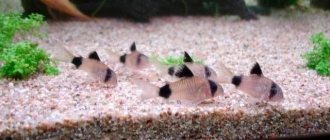Description and history of discovery
The brocade catfish pterygoplicht is one of the largest aquarium fish. This species was first discovered in 1845 by the Austrian ichthyologist and zoologist Kner. The scientist named it Ancistrus gibbiceps. Later, this species was included in the genus Pterygoplichts, but this happened much later, in 1980. And even later, already in 2003, the pterik was assigned to the genus Glyptoperichtidae. Under natural conditions, the size of this fish can reach up to 50 cm. However, the size of the fish in the aquarium is much smaller, and they directly depend on the size of the aquarium.
Pterik is one of the largest aquarium fish
If the fish in the aquarium is crowded, it may develop health problems, including even a shortened life expectancy. On average, a bird can live up to 15 years in an aquarium.
Pterygoplicht has a very original color: thick dark spots on a light golden background, its color can be compared with the color of a giraffe. Moreover, the color of females is always somewhat lighter than that of males. Another unusual difference is in the bony shell that protects the back and sides of the fish, and the high back fin distinguishes fish of this breed from other aquarium catfish.
The eyes and nose of the catfish are located high on the head, which is typical for most bottom-dwelling fish. The oral apparatus is represented by a combination of suckers and antennae. Males differ from females not only in color, but in size and the presence of tentacles with spines.
Varieties of Pterygoplichthus
Today, science knows of 14 different varieties of pterygoplichths, but some exist only in nature and are extremely rare. As for the species that can be kept in an aquarium, there are 6 main varieties:
- Brocade catfish;
- Leopard catfish;
- Reticulated catfish;
- Pterygoplichts Yoselmann;
- Yellow sailfish;
- Golden catfish.
The brocade catfish is one of the largest, its size can reach more than half a meter in length. Such individuals live up to 20 years. It has an unusually shaped fin studded with spines. The fish got its name due to its unusual black and gold color. Individuals of the leopard catfish in an aquarium live only up to 10 years, their maximum size reaches 50 cm. This species received special attention due to its unusual shape and coloring, reminiscent of the skin of a leopard.
Brocade catfish
Leopard catfish
Reticulated catfish
Interesting fact!
The netted catfish is gray in color with a pattern in the form of a fine mesh; individuals of this species can live in an aquarium for up to 20 years.
Yoselman's Pterygoplicht is a dark-colored fish covered with small golden spots. Its maximum size can be 35 cm.
The yellow sail catfish, compared to other species, is small in size - only up to 30 cm. It is distinguished by a large sail-shaped fin and an unusual color in the form of dark chaotic spots on a black background.
The golden catfish is called an albino due to its color: it has a light golden color, non-standard for catfishes.
Pterygoplichts Yoselmann
Yellow sailfish
Golden catfish
Description
There are several color options for catfish, they can be seen in the photo. All species have a pair of small antennae on either side of the mouth. The pelvic and pectoral fins practically touch each other during movement. Interestingly, this representative can be distinguished by its unique dorsal fin, which has the appearance of a sail. Thanks to him, the catfish received its name. The most striking and beautiful fin is found in young representatives. If we talk about primary colors, here you can see a magnificent variety of shades from gold to black. The lines located on the body are clearly visible in the photo because they have a delicate cream color. They are arranged like a leopard print. The pattern runs throughout the body and spreads to all the fins. The brocade pterygoplicht has an amazing feature: the stripes on its body change with age and their shape can be used to judge the age of the representative. Thus, young individuals have a bright pattern in the form of spots, and adults have lines that make up a kind of grid. All body pigmentation is very changeable, so age-related changes can be seen with your own eyes. At the end of life, the spots may disappear altogether.
The importance of this catfish in the food chain cannot be underestimated. It occupies an important place in the biological series of South America.
Natural habitat
The natural habitat of pterygoplichths is South America. They mainly live in the Amazon and Orinoco river basins; also, some species of this fish can often be found in the mountain rivers of the Andes. Pterygoplichts cannot be found in rapidly flowing fast rivers. They prefer silty areas of quiet rivers, shallows, etc. Quite often, bird species are combined into large groups.
By the way, those who consider catfish to be very calm and passive are mistaken. In nature, during the wet season, they become extremely active, the fish move a lot to get food. They eat algae and carrion as food. But this fish does not like dry periods; as a rule, it hibernates, burrowing deep into the silt.
On a note!
To date, pterygoplichts have been repeatedly spotted in the wild in Asia, Australia and other climate-friendly regions.
Another interesting feature of this fish is intestinal respiration. Pterygoplichts can capture air from the surface of the water and absorb it through the intestinal walls. The fish lives mainly at depth.
Description and habitat
Pterygoplicht brocade belongs to the family of chain-mailed catfishes. This is a large fish, growing up to 60 cm even in an aquarium. Scales are small bony plates covering the back and sides. The abdomen is smooth and tender, without scales. The entire body, including the fins, is covered in large brown or black spots bordered by yellow veins. Moreover, the size of the spots on the body is larger than on the head. This pattern makes the color look like leopard print. As a means of camouflage to the environment, other colors are also found: greenish, gray, olive.
With age, the outlines of the spots blur, the coloring fades, the pattern becomes reticulated or may blur, forming random stripes. In old catfish, the body color becomes uniform. There are also albino individuals without a characteristic pattern on the skin.
At a young age, pterygoplichts are very easy to confuse with plecostomus catfishes, which, when grown, have a more modest color and are much cheaper in price.
A characteristic feature of Pterygoplichthus brocade is the large fourteen-rayed dorsal fin, shaped like a sail. A tubercle protrudes in front of the fin, especially noticeable in adult specimens. The caudal and pectoral fins are also large. The upper part of the caudal fin is sloping towards the head. Thick bones in the pectoral fin framework help catfish burrow into the ground.
The head is large, with protruding nostrils and a highly developed leathery fold above them. Pterygoplicht brocade uses its mouth as a suction cup. A catfish can stick so tightly to other fish, glass or decoration surfaces that tearing it off is a very difficult task. The eyes of catfish are convex, like those of crustaceans, so they see not only what is happening in front, but also to the sides and behind. But against the background of the general color, the small black eyes are practically invisible.
The natural habitat of Pterygoplichtha brocade is the Amazon and Orinoco river basins. He chooses bodies of water with slow flows and areas that are flooded during the rainy season. Catfish prefer to live in the shallows, and when drought occurs, they can bury themselves in the mud in anticipation of rain. This is possible due to the ability of catfish to breathe not only through gills, but also to swallow air into the intestines.
Pterygoplicht brocade was moved to Asia, where it is now actively bred on farms for sale.
Behavior
In general, pterygoplichthys are known for their calm behavior. As a rule, they live on the bottom and lead a passive lifestyle. With some exceptions. In nature, their behavior is significantly different. More precisely, it directly depends on the time of year. During the rainy season, the fish are extremely active and can even rise to the surface to get food.
Pterygoplichthus feeds mainly on green algae and various types of carrion. The catfish also consumes oxygen from the surface of the water. Almost the rest of the time, most species of catfish prefer to hide at the bottom, buried in silt, and lead a sedentary lifestyle.
As for the behavior of pterygoplichts in the aquarium environment, they are extremely passive and calm. They spend most of their time at the bottom, hiding in algae or rocks; sometimes it may even seem that they have fallen asleep. Pterik does not interact or conflict with other types of aquarium fish. It is best to equip the aquarium with a special atmosphere, put stones on the bottom and plant algae so that the fish feels comfortable.
Catfish are peaceful by nature, but can conflict with their relatives
Range and Habitat
South America: Brazil, Ecuador, Peru and Venezuela, found in the Orinoco and Amazon basins.
Inhabits areas of rivers with weak currents, as well as places flooded during the rainy season. Inhabits the shallows of the Peruvian Pacaya River and the Brazilian Xingu and Tefe rivers.
During the dry season, they hibernate, hiding in holes about 1 meter long dug in the banks.
Appearance
The brocade catfish pterygoplicht has a rather original appearance, which is why it is very often chosen for your aquariums. This breed has an elongated, elongated body, the length of which can be over 50 cm. The body is covered on top and sides with a bony shell, and is soft on the abdominal side.
Like most species of catfish, the eyes and nostrils protrude significantly and are located on the top of the head, and the mouth is expressed in the form of a suction cup equipped with antennae. Thanks to the suction cups, this fish can hold well on vertical surfaces, such as the glass of an aquarium. Prominent bulging eyes can observe the situation not only in front of itself, but also from the side, and even behind. On the back of the fish there is a large sail-shaped fin, which contains more than 10 rays, and on both sides of the body there are fins similar to wings, arranged in such a way that they help the fish bury itself in the sand.
The color of the fish is golden, with many black thick spots. Thanks to its velvety smooth scales, similar to brocade, this fish got its name.
Description of appearance
Pterygoplichthus is a rather large catfish. It lives in the Orinoco and Amazon rivers, as well as their tributaries. When the rainy season arrives, the fish move to flooded areas, and during periods of drought, the catfish digs long holes in the mud and waits out unfavorable conditions there.
In a natural environment it can grow up to 50 cm in length, and in an artificial environment up to 45 cm. Moreover, its life expectancy is 20 years (in an aquarium up to 15 years).
The head of the fish is large, slightly elongated. The body is long, tapering towards the base of the tail. The catfish has a smooth belly and bony plates on its back, so touching it with bare hands is not recommended. It is worth noting the unique location of the fish’s eyes, which allow it to see everything not only in front of it, but also behind it. Pterygoplicht is a sucker catfish that is an excellent cleaner. Its mouthparts attach the catfish so firmly to the surface that it is impossible to tear it off without damaging the tissue.
The Brocade Catfish ranges in color from yellowish to black with golden beige lines forming a leopard skin pattern. There are individuals with a pronounced olive, yellow and even green tint.
Pterygoplichts albino
A distinctive feature of Pterygoplichthus is its dorsal fin. It reaches a height of 10-15 cm and has more than 10 rays, while other catfish have less than 8. The pectoral and ventral fins are located close to each other. The tail is beveled, the upper edge is shorter than the lower.
The male pterygoplicht differs from the females in its large size, bright color and slender body. Also, its pectoral fins have spines.
Differences between Pterygoplichthus and Ancistrus
Pterygoplichts and Ancistrus are considered the most popular species of Chain catfish. In terms of external characteristics, both of these species are very similar to each other, especially with regard to young individuals. However, they have many differences that directly affect the conditions of detention.
Firstly, fish have different body shapes. Pterygoplichthus has an elongated and slightly pointed head shape, while Ancistrus has a rounded head shape. This is especially clear if you look at the fish from above. And the whole body of ancistrus is more flattened, while pterygoplichts are much taller.
Attention!
One of the biggest differences is in size: Pterygoplicht can reach 50 cm in length, and Ancistrus no more than 15 cm, although in aquarium conditions they can reach the same small sizes.
In pterygoplichts the nostrils are always located above the eyes, while in ancistrus it is the opposite. Pterygoplichts can also be distinguished by the characteristic mustache on the lower part of the head and a pronounced hard dorsal fin, similar to a sail. Ancistrus has a smaller, rounded fin.
Upon closer inspection, you can find differences in color: Ancistrus is black with many golden patterns, and Pterygoplichts is golden with many black spots.
Pterygoplichths are sometimes confused with other species of bottom fish.
Appearance of catfish
The brocade catfish attracted the attention of aquarium fish lovers primarily with its appearance. It has a very original coloring, which resembles a leopard pattern made up of individual spots. Their colors vary from brown to black. Each spot is surrounded by a yellow border, which gives the catfish a leopard-like color. The pattern covers the entire body, head and even extends to the fins. Throughout the life of the fish, the colors of the spots and the entire pattern change. With age, the pattern becomes smaller, and in old age it may completely disappear.
The body of Pterygoplichthus appears flattened from above and rather elongated. In an aquarium, Pterygoplicht brocade can grow up to 20 cm. Scales in the form of bone plates cover the entire body except the lower abdomen.
The tall and beautiful fin on its back is shaped like a sail. It consists of 12-13 rays. The length of the first ray is comparable to the length of the head. The length of the entire dorsal fin occupies approximately half the length of the catfish's body. The pectoral and pelvic fins are curvy and practically touch each other. A large tail fin completes the fabulously beautiful image of the brocade leopard catfish.
Care and maintenance
The bird lives quietly in aquarium conditions and does not require any specific difficult conditions of detention. But there are still several conditions that must be adhered to when setting up an aquarium. Firstly, you must take into account that the brocade catfish is a large fish. And it requires a large aquarium volume. Under natural conditions, catfish can reach sizes of over half a meter. In an aquarium, of course, its size will be smaller, and it directly depends on the dimensions of the aquarium.
In this case, you must definitely monitor the oxygen level in the aquarium. Brocade catfish has 2 types of respiration: aeration and intestinal respiration. However, they cannot replace each other, so you need to ensure that the quality of the water always corresponds to what is required. If the owners notice that the fish often floats to the surface, this is a reason to check the oxygen level, since when feeling normal, the brocade catfish prefers to stay closer to the bottom and floats to the surface extremely rarely.
Contents of Pterygoplicht parchovog o
- not the most labor-intensive process, but it will still require constant monitoring and attention.
Aquarium
First of all, you need to choose the right aquarium. For a comfortable existence, the volume of the aquarium must be at least 250 liters, and you also need to take care of its internal contents. It will be very useful to place stones and driftwood at the bottom of the aquarium.
Note!
The aquarium must be equipped with a high-quality filter with a compressor.
As for the volume of the aquarium, 250 liters will be enough for only one fish. If you plan to place several individuals in the aquarium, then you need to choose larger sizes. As for the recommended form, there are no clear requirements. Most often, aquariums of a classic rectangular shape are chosen for pterygoplichts, but you can choose any other one if it is suitable in size.
Keeping pterygoplichts in a small aquarium not only does not allow it to reach large sizes, but also negatively affects the general condition of the catfish and significantly reduces its life expectancy. With proper maintenance, the fish can live up to 20 years; if the aquarium is cramped, then this period will be only 10 years or even less.
The main mistake when keeping a bird is placing it in a small aquarium.
Water
Particular attention should be paid to the condition of the water in the aquarium. Firstly, it must be clean and saturated with oxygen. You cannot do without a reliable filter with a compressor.
Water needs to be updated regularly. Water changes are usually carried out at least once a week. In this case, at least 30% of the total volume of water must be replaced. The water should have average acidity, and special attention should be paid to ensuring that the water does not contain nitrogen compounds harmful to fish.
The appearance of substances such as ammonia, phosphates, nitrates, etc. in water. can even lead to the death of the catfish. Therefore, it is best to always have special tests on hand that will help detect harmful substances in water. You can easily buy such tests in specialized stores.
There are also special preparations for water purification that remove particles of heavy metals and at the same time saturate the water with useful elements.
landscaping
Another important aspect when setting up an aquarium for brocade catfish is the preparation of algae and various aquatic plants. Pterygoplichts are very fond of quiet bodies of water without a current, overgrown with algae. This is exactly the environment that should be recreated in the aquarium so that the fish feels comfortable. Therefore, it is advisable to place as much vegetation as possible in your aquarium.
There are no clear standards for how many plants need to be planted, but there is one prerequisite: you must choose only those green algae that have a widely developed root system.
Pterygoplichts have the habit of burrowing into the ground with the help of fins, as a result of which all plants with poorly developed roots can be dug up without difficulty.
Among the most suitable aquatic plants are the following: Vallisneria, Cryptocoryne, Aponogeton, Echinodorus. To be sure that the brocade catfish will not dig up the plant, you can place small pebbles around it. When choosing algae, you need to take into account that the fish feeds on some varieties of aquatic plants.
The optimal water temperature is from 24 to 30°C
Lighting
Brocade pterygoplicht belongs to the nocturnal fish and does not need additional lighting; moreover, it is better to protect the aquarium from too strong and bright light.
Important!
You should not place the aquarium on a windowsill or near a window.
As for the evening and dark time of day, you need to install additional dim lighting. In the evening, the light must be turned on while feeding the fish. You can turn it off no earlier than half an hour after feeding, so that the catfish has time to eat all the food.
There are often cases when catfish are placed in an aquarium along with other fish that need more light. Additional lighting sources are used, but care must be taken to ensure that the pterygoplicht has the opportunity to hide in the shadows. This is done with the help of abundant green spaces and aquarium decor items.
Decor
The decor and interior design of the aquarium is one of the most important conditions for keeping pterygoplichts. You need to pay attention to the soil. The bottom should be soft sandy, as this type of fish loves to burrow into the ground. It will also be useful to sprinkle pebbles and pebbles on the bottom of the aquarium.
You definitely need to place one or more driftwood in the aquarium. Pterygoplichts love them very much. Firstly, the fish will be able to hide in its shadow, and secondly, eating driftwood will allow the fish to compensate for the lack of cellulose in the body, which is also important. From time to time, driftwood needs to be changed. As for the material of the driftwood, it does not matter much.
In addition, it will be useful to install various decorative shelters in the aquarium, for example, houses, grottoes, ceramic pipes and much more. You can purchase ready-made shelters at a pet store, or you can make them yourself from improvised materials. The use of such devices is especially important if other fish live in the aquarium together with the pterygoplicht.
Catfish loves privacy, shade and silence, and such devices will allow you to recreate the ideal environment for him. If all conditions for keeping pterygoplicht are met, the fish can live in an aquarium for up to 20 years.
When creating a pond, you need to take care of shelters
Features of care and maintenance
For a fish such as Pterygoplicht brocade, keeping it in an aquarium has some distinctive features. In general, this process is not too complicated.
Until the body size of a young catfish reaches 12-13 cm, it can be kept in a relatively small aquarium - about 90 cm wide. After the fish grows up, it needs to be transplanted into a larger reservoir - at least 300 liters and a width of 120 to 130 cm .
An adult couple will require an aquarium volume of at least 400 liters. If you keep young fish in cramped aquariums, they stop growing and begin to get sick, and their life expectancy is significantly reduced.
Mandatory requirements for the aquarium:
- good aeration;
- a powerful external filter, since catfish very quickly pollute their homes;
- replacing water every week by ¼ of the total volume;
- water temperature in the range 24⁰С—30⁰С;
- slightly acidic reaction of water;
- average level of hardness dH from 4⁰ to 20⁰
It will be very useful to place driftwood in the aquarium. For normal digestion, pterygoplichts need cellulose, which they obtain by scraping the surface layer of wood.
Since catfish are bottom-dwelling fish, natural soil is important for them. The best option is river pebbles and small stones.
If the catfish is hungry, it can eat the plant
. To create conditions as close to natural as possible, experienced aquarists resort to some tricks. Catfish feel much more comfortable if the “environment” in the aquarium closely resembles the river environment in their homeland. To recreate the necessary conditions, you can use large smooth stones, artificial tunnels and shelters, and aquarium plants.
Adults, if there is a lack of food, can uproot and eat aquatic plants such as lemongrass or sinema. Therefore, it is better to plant cryptocorynes, vallisneria or apogetons in the aquarium. In general, catfish are unpretentious in terms of vegetation, so you can plant any plants to your taste. The algae must be carefully fixed in the ground so that large fish do not break or damage the algae in any other way.
Nutrition
The diet of the catfish pterygoplichtas consists of food of animal and plant origin. Plant foods should make up approximately 80% of the diet, and animal foods should make up about 20%. Often, owners feed their fish with natural vegetables: carrots, zucchini, lettuce. But vegetables greatly affect the quality of water in the aquarium and greatly clog it.
As for animal food, it is better to use bloodworms or tubifex. However, live bloodworms can lead to infection in the aquarium.
One of the best solutions is to use ready-made dry fish food. Their advantage is that such food already contains all the necessary nutrients and breaks down into small grains in the aquarium, as a result of which the water in the aquarium practically does not become clogged. Food in tablets can contain both vegetable and protein supplements.
Note!
It is necessary to place driftwood at the bottom of the aquarium; the fish gnaw the wood, thus obtaining cellulose, which has an extremely beneficial effect on the digestion of pterygoplichts.
Compatibility with other fish
Pterygoplichts are quite peaceful fish, especially since they are passive most of the time and do not show aggression towards other inhabitants of the aquarium. In particular, cichlids, giant gouramis or polypterus will be good neighbors for catfish. Even Flowerhorn, which is dangerous for most aquarium fish, exists peacefully with catfish.
However, in relation to its own relatives, in particular ancistrus, pterygoplicht can behave quite aggressively and in every possible way survive unwanted guests from its territory. Therefore, it is better not to put two related species of fish in the same aquarium in order to avoid competition between them.
In general, the brocade catfish lives peacefully with most large aquarium fish. Moreover, it can even be added to an aquarium with some predatory fish, since thanks to its reliable shell, the brocade catfish is protected from attacks by predatory fish.
But it is better not to house Pterygoplichtas with small fish; the catfish does not attack other fish, but can accidentally eat them. In its natural environment, the catfish often picks up various carrion from the bottom, and can even eat small shrimp.
The compatibility of Pterygoplichthus with other fish is unique
Compatibility of Pterygoplichts with other fish
Despite the fact that catfish have impressive sizes, in the same aquarium they can get along even with small fish. The main thing is that the reservoir is filled with a large number of different algae.
It is not recommended to house veil fish with brocade catfish. This is explained by the fact that catfish can attach themselves to the body or tail of a slow neighbor, after which there may be practically nothing left of its veiled fins. Also, pterygoplichths may have problems with other cleaners that are competitors in food. These include Ancistrus and Gerinocheilus.
Reproduction
Sexual maturity in Pterygoplichthus specimens occurs at approximately 3 years of age. The average size of the fish at that time is 20-25 cm. Males, as a rule, are brightly colored and larger than females. Fish breed only in the wild or on specially created farms, where all conditions are as close to natural as possible. In nature, catfish dig quite large holes and lay their eggs there. In this case, the male guards the entrance after the female lays eggs in the created tunnel. These tunnels reach a depth of several centimeters, which is why it is impossible to achieve the reproduction of fish in artificial conditions.
Catfish spawning always occurs at night; in one night a fish can lay from 100 to 500 eggs, but not all of them hatch into fish. The hatched fry are dark gray in color and covered with black dots. The fish become similar in color to their parents only after a few months.
Most of the fry for sale are raised on special farms located in the USA, Australia and South America. There, catfish breeding is carried out in large ponds that are as similar as possible to the fish’s natural habitat.
Fish reproduction
In their homeland, pterygoplichthys go into deep burrows and tunnels dug near the river bank during the breeding season. The female hides in such a hole and lays eggs, while the male guards the entrance. After the fry are born, the males take full charge of caring for them.
It is impossible to create such conditions in a home aquarium, so it will not be possible to propagate the brocade catfish at home. An adult couple living together in the same aquarium will not lead to offspring.
For breeding brocade catfish, special farms are built in East Asia, Australia and the USA. Here the fish are grown for commercial purposes - they are transported to pet stores all over the world, since Pterygoplichthus is incredibly popular.
They require an appropriate climate to reproduce.
How to distinguish a male from a female
Male ancistrus can boast of clearly expressed sexual characteristics - there are numerous growths on their upper jaw. They are often called mustaches, beards or horns.
It is interesting that females find these growths attractive; they give preference to those males in which this dimorphism is most pronounced.
A less noticeable feature is the size of the body: males are larger, but at the same time more graceful. Girls have a more rounded abdomen, and growths on the upper jaw are only 1 mm long.
How to distinguish between a female and a female
Of course, males and females of the brocade pterygoplicht have some differences, but for an inexperienced person it can be very difficult to distinguish them from each other, especially for young individuals. Perhaps only an experienced aquarist will be able to easily determine the sex of an individual. Among the main differences are the following:
- Color and sizes. On average, males are several centimeters larger than female catfish. At the same time, they have a more saturated color, the color of the spots is more saturated, and in general the individuals look brighter.
- Pectoral fins. Large voluminous fins on the chest are present in both males and females. These fins are designed not only to swim, but also to burrow into the ground. In males, these fins are additionally equipped with spines.
- Genital papillae. Another difference is the different arrangement of the genital papillae in Pterygoplichthus specimens. In males they are noticeably protruding, while in females they are firmly pressed to the body.
But even all these conditions do not allow one to accurately distinguish a male from a female, so it is better to seek advice from an experienced aquarist.
Sexual demorphism in these catfish is rather weakly expressed
Differences between males and females
When it comes to a breed like the brocade catfish, it can be difficult to distinguish males from females. Usually only experienced aquarists can do this . Among the characteristic features are taken into account:
- Body size and coloring - males are larger and brighter.
- The pectoral fins of males have sharp, long spines.
- In males, the genital papillae protrude, while in females they are pressed to the body.
In this video you will learn more about catfish: https://youtube.com/watch?v=KCnpzwgiO6k
Such signs are quite relative and do not always allow one to determine the gender of an aquarium inhabitant.
Diseases and prevention
Brocade pterygoplicht is one of the most unpretentious and disease-resistant aquarium fish. However, if not maintained correctly, even they can be susceptible to various diseases. For example, if the owner does not change the water in the aquarium regularly enough, solid metals and withdrawal products can accumulate in it, which negatively affect the condition of the fish and even lead to the appearance of holes in the fins of catfish.
You can identify a sick fish by a change in behavior: the catfish begins to behave restlessly or, conversely, excessively apathetic. If the color changes and the condition of the fish’s scales changes, then there is a high probability that the catfish has been exposed to a fungal disease. If purulent formations appear on the fish’s body and its abdomen turns white, this is a sure sign of bacterial infections.
To avoid fungal and bacterial diseases, you need to monitor the conditions in which the fish are kept and regularly clean the aquarium and update the water.
Diseases and treatment
Brocade catfish are highly resistant to diseases; if properly maintained, they have excellent health. However, in case of unfavorable conditions, even such “strong ones” can be overtaken by diseases characteristic of aquarium inhabitants:
- If the water in the aquarium changes irregularly and metabolic products accumulate in it, holes may form in the catfish's fins.
- The absence of driftwood in a pond provokes digestive disorders.
- A sick fish may change its behavior - it becomes restless, hides even at night, or, conversely, begins to hit the walls of the aquarium.
- Ichthyophthyrosis is a disease caused by ciliated ciliates. This disease can affect almost all aquarium inhabitants. These single-celled parasites invade the fish's body, its fins and gills. Soon whitish spots appear on the surface of the skin. Sick fish become weak and float to the surface. The death of an individual occurs from suffocation.
- Many fungal and bacterial infections in catfish manifest themselves in changes in skin color, loss of scales, or the appearance of pustules on the surface of the body. The belly or back may turn white.
There are a number of treatment recommendations
It can be difficult to recognize the disease in pterygoplichts due to the fact that the fish is nocturnal and during the day hides under snags or in caves.
To get rid of ichthyophonosis, it is necessary to raise the water temperature in the aquarium to 30 degrees or transfer the sick catfish to a weak salt solution. Preventing diseases is easier than treating them. To do this, you need to carefully follow the rules of care, keep the aquarium clean and regularly update the water. With proper care, pterygoplicht will live and delight with its appearance for 10 years or more.
Price
The cost of one individual brocade catfish can vary significantly depending on the size of the individual, its age, species and even region. For example, the average cost of one individual brocade pterygoplicht can be from 350 rubles. Often fry can be purchased even cheaper.
The younger the age and smaller the size of the catfish, the cheaper it will be to purchase. For example, the cost of a fish up to 7 cm in size can range from 250 rubles per individual. But the price of an adult catfish can be much higher and often reaches several thousand rubles. The purchase and arrangement of an aquarium will cost no less than 3-5 thousand.
It is best to purchase and equip it before purchasing the fish, since it is extremely dangerous for them to be outside the aquarium, even for several hours. It is best for novice aquarists to consult with experienced people when purchasing a catfish and equipment for it.
Brocade catfish reviews
Some are interested in the question of whether it is possible to breed catfish at home. The answer is no. They require special conditions for spawning, which are simply impossible to recreate at home. Fry sold in pet stores are bred on special farms. It cannot be said that pterygoplicht is a very capricious aquarium fish, but proper maintenance and care are very important for it.
Would you like to purchase Brocade Pterygoplicht for your own aquarium? Share in the comments!
Behavior and Compatibility
This fish is extremely popular in the aquarium due to its unusual appearance and ability to eat algae.
It is peaceful towards other fish; territorial disputes may arise with its relatives. Although they are not nocturnal, they are more active at night and spend the daytime hours “hiding” in a secluded area.
They are usually purchased quite small, but these fish grow quickly and can become too large for small aquariums.
